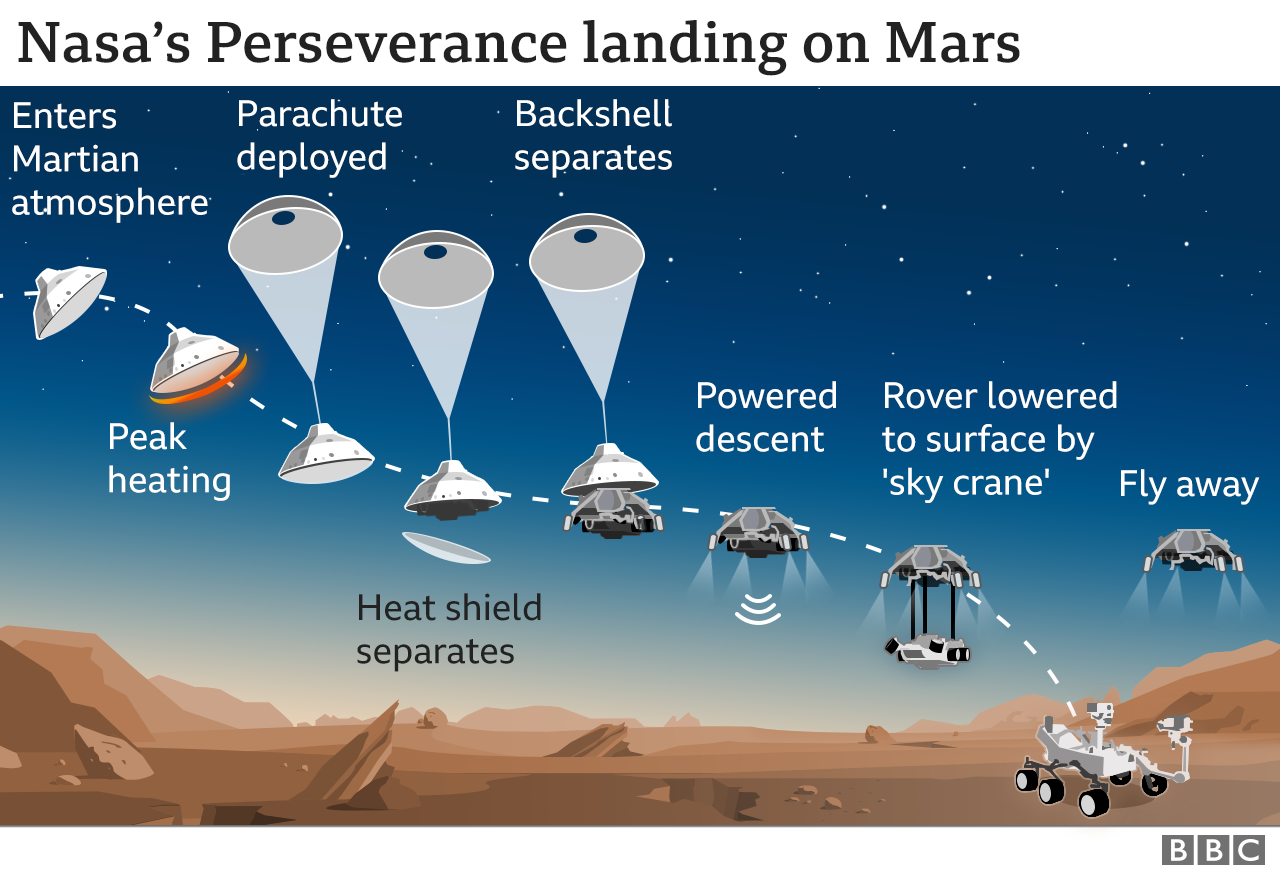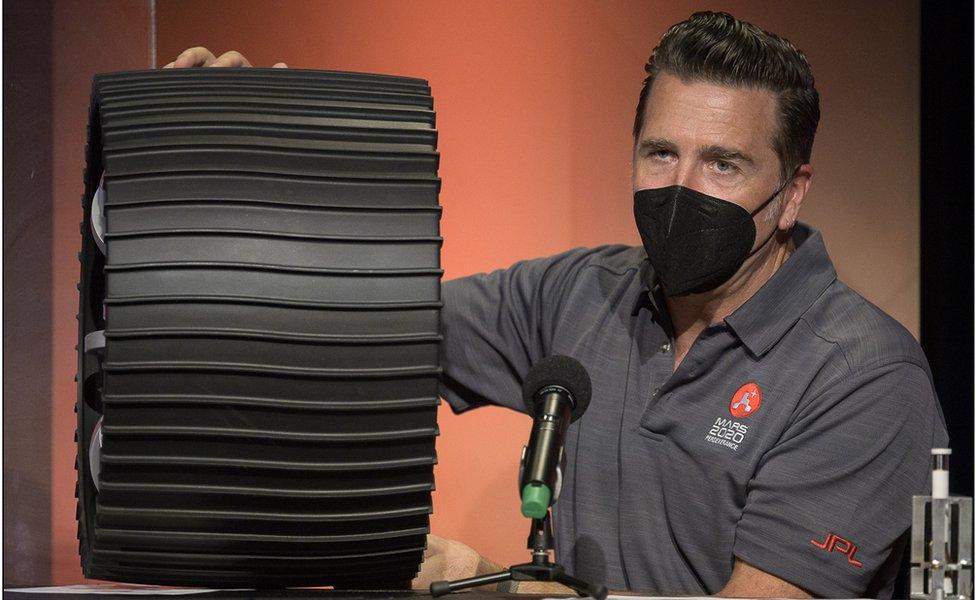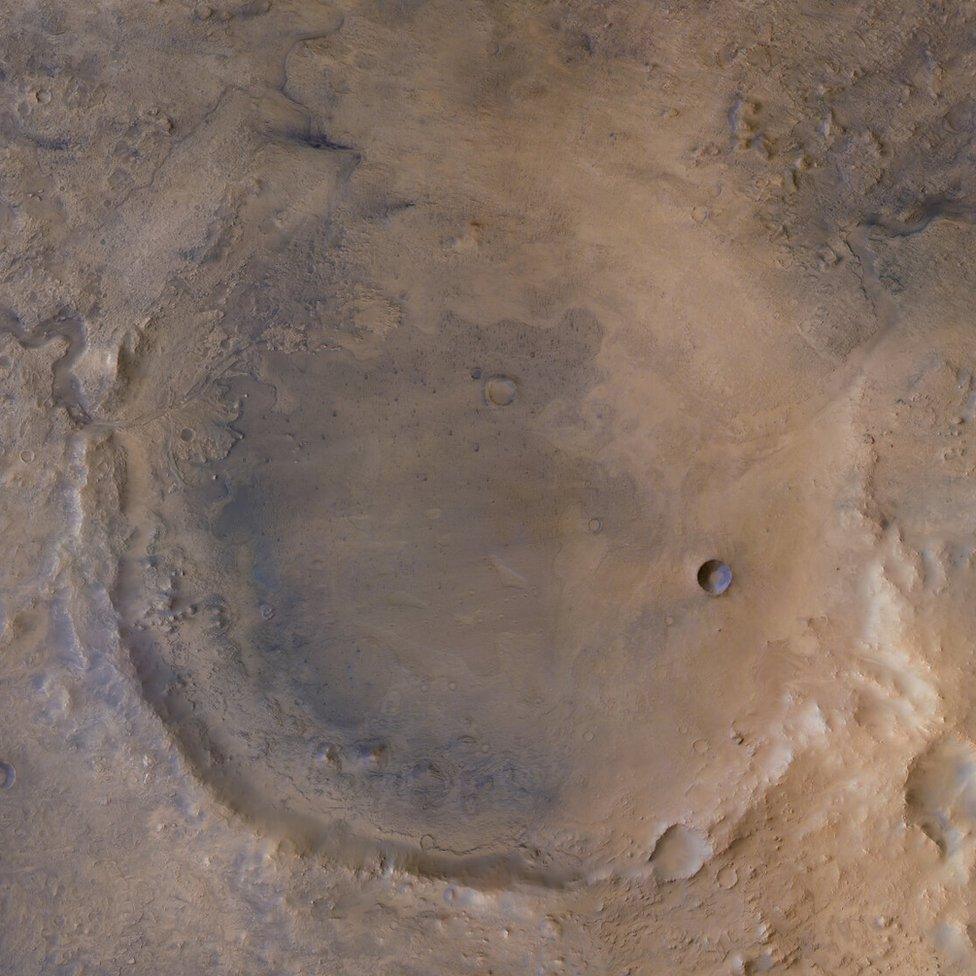Perseverance rover: Nasa robot heading for a bulls-eye landing
- Published
New technology aboard Nasa's Perseverance rover will help it avoid landing hazards, such as cliffs and rocks
The American space agency says its Perseverance rover is lined up perfectly for its landing on Mars.
The robot is heading for a touchdown on Thursday in a crater called Jezero just north of the planet's equator.
Its mission objectives will be to search for signs of past life and to collect and prepare rock samples for return to Earth in the 2030s.
Engineers told reporters that as things stand they don't plan to make any more changes to the robot's trajectory.
All the navigation data indicates it is right on track to intersect Mars at the intended moment in time and space.
WATCH: Mars landings that did (and didn't) go to plan
"We still have the ability to do another manoeuvre if we need to, but we don't expect we'll have to," Jennifer Trosper, Nasa's deputy project manager for Perseverance, told BBC News.
Tuesday saw Perseverance duck under half-a-million km left to travel, external.

A signal from the rover to say its protective capsule has engaged Mars' atmosphere should arrive on Earth at about 20:48 GMT on Thursday. If all goes well, confirmation that the robot is safely on the ground will come roughly seven minutes later.
Mission control at the agency's Jet Propulsion Laboratory in California will be following events in arrears.
The current 190m-km separation between the planets means all communications take over 11 minutes to arrive, making it impossible for engineers to intervene if something does go wrong. Autonomous systems on Perseverance are in charge.
To the casual eye, the robot looks exactly the same as the Curiosity rover that Nasa put down in Gale Crater in 2012. But "under the bonnet", the new vehicle is quite different, with an enhanced suite of instruments that will enable it to address a new set of scientific questions.

Perseverance has more robust wheels than its predecessor, Curiosity
The hope is it's also more robust than Curiosity, said chief engineer Adam Steltzner
"Curiosity's wheels took quite a beating on the surface of Mars because of the these sharp rocks called ventifacts," he explained. "Perseverance has a gentle tread pattern. That tread pattern not only makes her wheels stronger against rocks, it also gives them better performance in sandy terrain."
Fans can also look forward to an upgraded multimedia experience. This mission carries more than 20 cameras and a couple of microphones. Two of the cameras are on a mini-helicopter that will try to fly in Mars' rarefied atmosphere.
Dr Thomas Zurbuchen: "'Perseverance' is our battle cry"
This will be the first Nasa Mars mission - since the Viking landers in the 1970s - to look directly for signs of life.
The intervening years have all been about habitability - about whether past conditions might have been suitable to host biology. That question has been convincingly settled.
Missions such as the Spirit and Opportunity rovers in the 2000s, and more recently the Curiosity robot, have all shown that Mars was once a warmer and wetter world. It had all the chemical prerequisites to support microbial organisms - if ever they existed.

Jezero: Roughly 45km in diameter, the crater held a lake billions of years ago
It's now Perseverance's job to go look for the traces this primitive life might have left behind in what are thought to be the sediments of a once great lake in Jezero.
"Like geologists who study Earth's earliest life, we're looking for microbial life - microbes that have made a little mat or a slime of sorts that you might find at the bottom of a pond," science team member Bethany Ehlmann, a professor of planetary science at the California Institute of Technology, told BBC News.
"We know those types of things existed on Earth three-and-a-half billion years ago. The question is, did they also exist on Mars at the bottom of lakes three-and-a-half billion years ago?"
The reality is that it will be hard for Perseverance to be able to prove it definitively on the spot.
It's common for examples of ancient life on Earth to be hotly debated, which is why the rover will be packaging its most interesting rock finds in small tubes to be sent home later this decade.
A helicopter the size of a Chihuahua will explore Mars
Nasa and the European Space Agency have put together a multi-billion-dollar plan to achieve this.
It will see a smaller rover launched in 2026 to scuttle around Jezero and pick up the samples tubes left behind by Perseverance.
These will be blasted into Mars orbit where they'll be caught by a satellite and brought back for the superior analysis in Earth laboratories.
In the longer term, the aim is to get astronauts to Mars, and Perseverance will carry an experiment to see if it's possible to make breathable oxygen from the planet's predominantly carbon dioxide atmosphere.
Humans would inevitably follow the robots at some stage said Nasa's head of science, Dr Thomas Zurbuchen.
"We have a lot of robots on Earth, and we have aerial imagery from autonomous airplanes. But if you really want to understand the geologic context of a sample up there in the mountains in the Himalayas, or the Alps, or wherever it may be - you are going to go with humans. And we want to do the same with Mars," he told the BBC.
